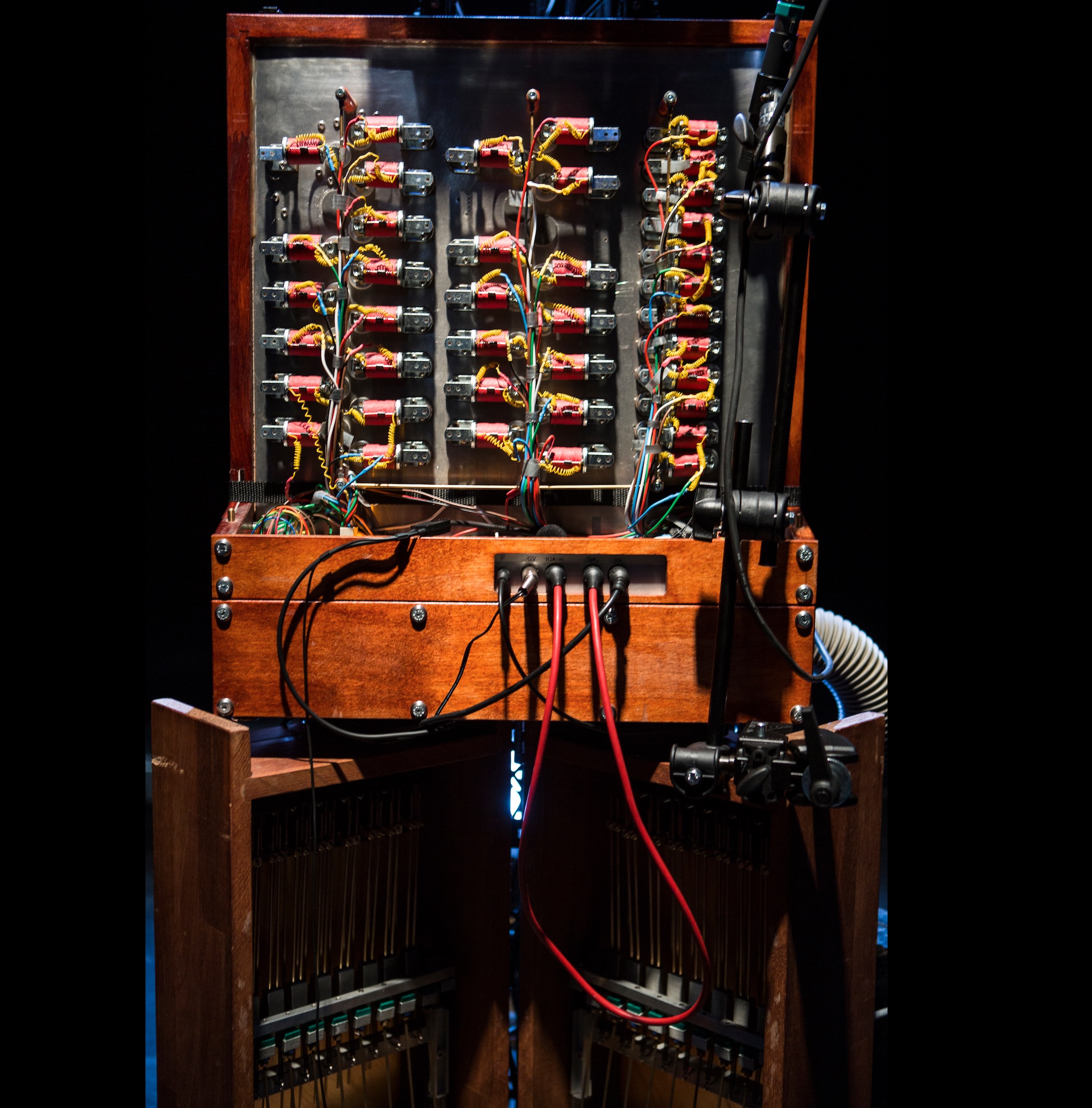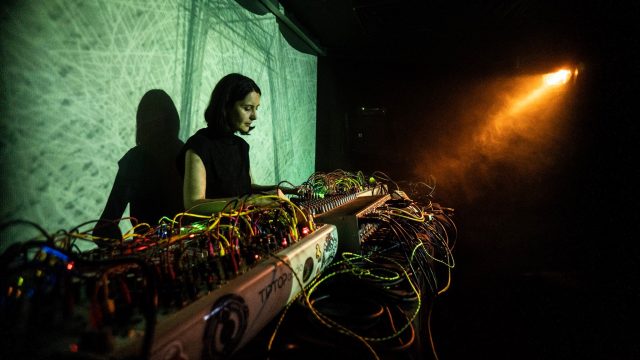GAMUT INC is a Berlin-based experimental music ensemble consisting of Marion Wörle and Maciej Sledziecki. Following a long and deep studies of material and sound the two music smiths forged fantastic music-machines out of hundreds of screws, nuts in many variations, threaded rods and wires in various colors. These apparatus are later controlled through a computer, which make their performances more appear like a scientific research.
Sound exploration is what the three piece series “Aggregate” is all about, that will launch 24 March at ACUD Club. The two musicians want to try to expand the sound of their ensemble and study the interaction of human and machine through confrontation of invited artists with their computer-controlled music machines. Participating in the first live experiment is “desert trombonist” Hilary Jeffery. Homepage
Could you introduce your most favorite instrument: What is it?
Hard to say. At the moment we like them all, since we think of our machines as a whole ensemble: SPECHT (german for “woodpecker“) is our newest one: It has 16 steel-rods which mounted to cigar boxes and which are hit by computer-controlled solenoids. You can imagine it be some kind of meta Glockenspiel, that can make insanely fast tone-repetitions that go almost beyond the speed where the human ear can distinct between different rhythmical impulses.
Another one is the BOWJO, a motorized electro-magnetic banjo. It has three bottlenecks attached to stepper-motors, thus making glissandos and microtonal shifts possible. The strings are driven by ebows or plucked by motorized plectra. All functions of our instruments are controlled by computer, but make an acoustic sound.
The most complex instrument is probably the PHYSHARMONICA, a kind of automated accordeon. But also here the automatization of the the tone-valves and many aspect of the wind flow allow us to create many weird and beautiful sounds and timbres. Finally we have automated percussions like a timpani and cabasas.
How would you describe their sound?
Curious, peculiar, psychotic, harsh, spheric, unique… we like it the most, when we reach a sound at the border of acoustic and electronic. There is a range of timbres that no human performer could play – and that´s what we´re after.
What’s most difficult about playing them? What’s the most fun?
There is a lot of technic and wires involved, not so easy to start playing sponatneously. BUT if the whole system is set up and everything connected to each other, and there is a good PA and a nice sub, it´s really something!
Did you build them yourself?
Most instruments we play now, are build and designed to a large extend by ourselves. With the exception of the PHYSHARMONICA, which was build completely by the instrument-builder Gerhard Kern based on collective ideas.
How do I built my own instrument?
You should know what you want first — visualize the sound you´re after, the sonic range and the actual way to control the instrument. Then take your time with testing small parts of the machine — it´s more than likely that some (or all) of your design will not work. That´s absolutely normal and why you should make tests before building a whole apparatus. You end up very quickly in work areas like electronic engineering, metal- and woodworks, soldering and programming, where you´re probably an amateur (like we are). It takes research, the right tools, a workshop, and a lot of time! You need to learn for example how a resonance body works and which sorts of wood you need (cigar boxes are great and cheap). Concerning electronics we use Arduino and ChipKit micro controllers to drive the motors and solenoids of the machines — they have great communities that can be very helpful. After saying this: Did we mention already that it´s good to start with a small and relatively simple project? For example working with one solenoid, and solder a circuit that can actuate that. Already you have a profound basis for a drum-machine !
Could you tell us about the materials you used?
Wood, aluminium, steel, hundreds of screws and nuts in many variations, threaded rods, solenoids, stepper motors, servos, micro-controllers, tin solder, wires in various colours and many tiny components. We also misuse existing instruments like a banjo, a timpani, some registers from an organ, a cabasa and more.
How did you learn playing them?
We control the instruments from our laptops via MIDI commands. There are software-patches involved, which we first build with the open-source programming language Pure Data. Later we switched all our tools to Max4Live, so we could integrate our music in Ableton Live. This made it way easier to work with presets, timelines and external controllers. We´re still learning how to make intuitive access to the sounds we´re working with. The longer you play the instrument, the more ideas come up. That´s why we rebuilt most of our machines: The percussions are in a state of permanent transformation, BOWJO and PHYSHARMONICA have a predecessor each, SPECHT has even three ! We both learned how to play a traditional instrument and this has an impact on the way how we create and play music.
Who did you inspire to build the instruments?
It started when we met the instrument-builder Gerhard Kern. He showed us his workshop on the countryside, filled with wonderful self-built machines. We borrowed some of his instruments and played concerts with them. After that we were addicted, and wanted to explore the possibilities of machine-music in depth. That´s what we did since 2013 when we started, and that´s where we want to go farther with the concert-series AGGREGATE at ACUD. We will confront the machines with some of our favorite musicians, to explore how to expand the ensemble´s sound. What are interesting timbres and composition-methods that let humans and machines interact with each other meaningfully? We´re looking forward to all this collaborations. End of September we will go even deeper into machine music, since we got the chance to invite many important machine-music ensembles to Berlin for the WIR SIND DIE ROBOTER festival. There you will truly experience the whole gamut!






